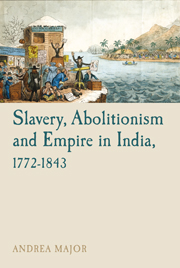Book contents
- Frontmatter
- Contents
- List of Illustrations
- Acknowledgements
- List of Abbreviations
- Glossary
- Some Prominent Figures in the British Parliament, the Abolitionist Movement and the East India Company
- Part I Other Slaveries
- Part II European Slaveries
- Part III Indian Slaveries
- Introduction: Locating Indian Slaveries
- 4 ‘This Household Servitude’: Domestic Slavery and Immoral Commerce
- 5 ‘Open and Professed Stealers of Children’: Slave-trafficking and the Boundaries of the Colonial State
- 6 ‘Slaves of the Soil’: Caste and Agricultural Slavery in South India
- Part IV Imagined Slaveries
- Conclusion: ‘Do Justice to India’: Abolitionists and Indian Slavery, 1839–1843
- Select Bibliography
- Index
Introduction: Locating Indian Slaveries
from Part III - Indian Slaveries
- Frontmatter
- Contents
- List of Illustrations
- Acknowledgements
- List of Abbreviations
- Glossary
- Some Prominent Figures in the British Parliament, the Abolitionist Movement and the East India Company
- Part I Other Slaveries
- Part II European Slaveries
- Part III Indian Slaveries
- Introduction: Locating Indian Slaveries
- 4 ‘This Household Servitude’: Domestic Slavery and Immoral Commerce
- 5 ‘Open and Professed Stealers of Children’: Slave-trafficking and the Boundaries of the Colonial State
- 6 ‘Slaves of the Soil’: Caste and Agricultural Slavery in South India
- Part IV Imagined Slaveries
- Conclusion: ‘Do Justice to India’: Abolitionists and Indian Slavery, 1839–1843
- Select Bibliography
- Index
Summary
In March 1808, J. Richardson, EIC magistrate for Bundlekhund, wrote a detailed letter to the local judicial authorities in which he advocated the suppression of slavery throughout the EIC's territories. His intervention on this ‘subject of great importance to the cause of humanity, policy, morals and religion’ was prompted by the British parliament's recent ‘humane abolition of the slave trade’, which, he remarked, had ‘added lustre to the enlightened wisdom on the British senate, and enrolled, to the latest posterity, the name of Wilberforce amongst the benefactors of mankind’. Richardson, who was clearly influenced by abolitionist sentiment and Smithian ideas about free labour as the most efficient and rational method of capitalist production, put forward a comprehensive case for suppressing slavery, on both principled and practical grounds, arguing for a ban on the buying and selling of slaves, and for a declaration making all children born to slaves in India after a certain date free. Although the judges of the Nizamat Adalat, the chief criminal court of the Bengal Presidency, were initially moved by his letter to collect detailed opinions on the legal status of slavery from their Hindu and Muslim advisers, and even asked Richardson to outline his thoughts on how to ameliorate the practice in the light of these, the resulting draft regulation was not forwarded to government until 1816. The official explanation for this delay was ‘the difficulty of the subject, as well as the pressure of other business’—Indrani Chatterjee believes that Richardson's minute was deliberately suppressed as too problematic.
- Type
- Chapter
- Information
- Slavery, Abolitionism and Empire in India, 1772–1843 , pp. 123 - 130Publisher: Liverpool University PressPrint publication year: 2012



